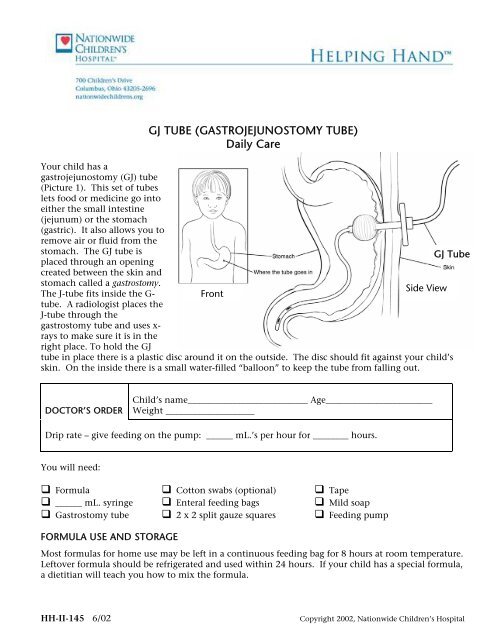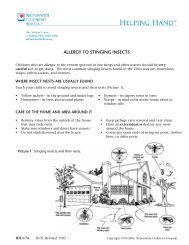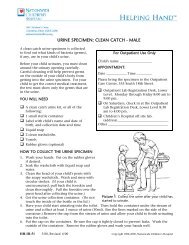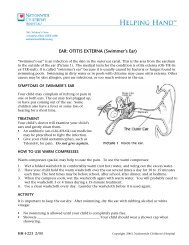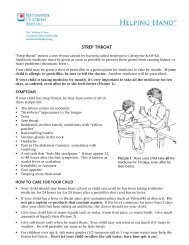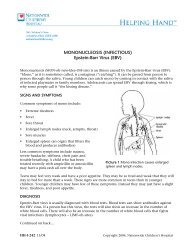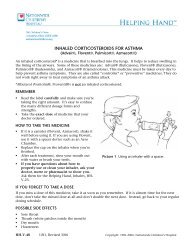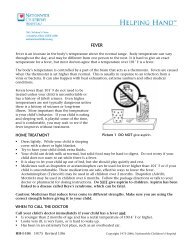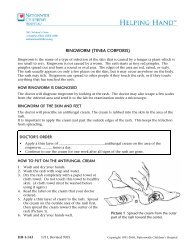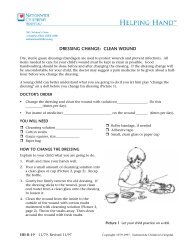GJ TUBE (GASTROJEJUNOSTOMY TUBE) Daily Care
GJ TUBE (GASTROJEJUNOSTOMY TUBE) Daily Care
GJ TUBE (GASTROJEJUNOSTOMY TUBE) Daily Care
You also want an ePaper? Increase the reach of your titles
YUMPU automatically turns print PDFs into web optimized ePapers that Google loves.
<strong>GJ</strong> <strong>TUBE</strong> (<strong>GASTROJEJUNOSTOMY</strong> <strong>TUBE</strong>)<br />
<strong>Daily</strong> <strong>Care</strong><br />
Your child has a<br />
Picture 1 The <strong>GJ</strong> Tube inside the body.<br />
gastrojejunostomy (<strong>GJ</strong>) tube<br />
Disc<br />
(Picture 1). This set of tubes<br />
lets food or medicine go into<br />
either the small intestine<br />
(jejunum) or the stomach<br />
(gastric). It also allows you to<br />
remove air or fluid from the<br />
stomach. The <strong>GJ</strong> tube is<br />
<strong>GJ</strong> Tube<br />
placed through an opening<br />
created between the skin and<br />
stomach called a gastrostomy.<br />
Side View<br />
The J-tube fits inside the G- Front<br />
Side View<br />
tube. A radiologist places the<br />
J-tube through the<br />
gastrostomy tube and uses x-<br />
rays to make sure it is in the<br />
right place. To hold the <strong>GJ</strong><br />
tube in place there is a plastic disc around it on the outside. The disc should fit against your child’s<br />
skin. On the inside there is a small water-filled “balloon” to keep the tube from falling out.<br />
DOCTOR’S ORDER<br />
Child’s name___________________________ Age________________________<br />
Weight ____________________<br />
Drip rate – give feeding on the pump: ______ mL.’s per hour for ________ hours.<br />
You will need:<br />
Formula<br />
______ mL. syringe<br />
Gastrostomy tube<br />
Cotton swabs (optional)<br />
Enteral feeding bags<br />
2 x 2 split gauze squares<br />
Tape<br />
Mild soap<br />
Feeding pump<br />
FORMULA USE AND STORAGE<br />
Most formulas for home use may be left in a continuous feeding bag for 8 hours at room temperature.<br />
Leftover formula should be refrigerated and used within 24 hours. If your child has a special formula,<br />
a dietitian will teach you how to mix the formula.<br />
HH-II-145 6/02<br />
Copyright 2002, Nationwide Children’s Hospital
FEEDING<br />
When you feed your child through the <strong>GJ</strong> tube,<br />
you will use a pump to control how fast the<br />
formula goes in. We will teach you what drip<br />
rate to use and how many hours to give the<br />
feedings. You will give feedings into the<br />
jejunostomy part and not into the stomach<br />
(gastric) part. The jejunostomy part is either<br />
labeled “Jejunal” or it has a red cap.<br />
The radiologist will make sure that you know<br />
which part to feed into. During the feeding,<br />
the tube should be flushed every 4 hours to<br />
prevent clogging.<br />
1. Using a syringe, flush 15 mL. of warm tap<br />
water into the jejunostomy part of the tube<br />
(Picture 3).<br />
2. Warm the formula in a pan of warm water<br />
so that it is at least room temperature.<br />
Never warm formula in a microwave.<br />
3. Pour a drop of the formula on the inside of<br />
your wrist to test the temperature. It<br />
should be warm, not hot.<br />
4. Pour the formula into the formula bag.<br />
5. Hang the formula bag on a hook or on the<br />
pole with the feeding pump.<br />
6. Let the formula fill the entire length of the<br />
tubing, as instructed by your home care<br />
agency.<br />
7. Attach the tubing to the jejunostomy part<br />
of the <strong>GJ</strong> tube (Picture 4).<br />
8. Set the drip rate on the pump and start the<br />
machine.<br />
<strong>GJ</strong> Tube: <strong>Daily</strong> <strong>Care</strong> Page 2 of 5<br />
Red cap<br />
Picture 2 Two kinds of <strong>GJ</strong> tubes.<br />
BETWEEN FEEDINGS<br />
The <strong>GJ</strong> tube should be flushed every four hours<br />
to prevent clogging. To do this, turn<br />
off the pump and disconnect the tubing from<br />
the <strong>GJ</strong> tube. Flush the <strong>GJ</strong> tube with 15 mL. of<br />
warm water with a syringe. Reattach the pump<br />
tubing and start the feeds again. When feeding<br />
is over, flush again with 15 mL. of warm tap<br />
water.<br />
• Infants may enjoy using a pacifier,<br />
especially during the feeding, to satisfy<br />
sucking needs (Picture 5, page 3).<br />
• If your child cries during the feeding, stop<br />
the feeding until your child is quiet and<br />
comforted.<br />
Picture 3 Flush the jejunostomy part of the tube.<br />
Cap<br />
Picture 4 Attach the tubing to the <strong>GJ</strong>-tube.
MEDICINES<br />
You may give medicine through either the<br />
jejunostomy or gastrostomy part of the tube.<br />
Your doctor will tell you which part to give<br />
your child’s medicines through. Flush the tube<br />
with 15 to 30 mL. (1 ounce) of water after the<br />
medicine has gone through.<br />
<strong>GJ</strong> Tube: <strong>Daily</strong> <strong>Care</strong> Page 3 of 5<br />
Liquid medicines – Mix them with tap water<br />
to make about 10 to 20 mL.. Use a catheter-tip<br />
syringe to slowly push the medicine into the<br />
tube. Then slowly flush the tube with 15 to 30<br />
mL.’s of tap water.<br />
Pills – (Check with your doctor or pharmacist<br />
before crushing pills.) Crush the medicine into a<br />
powder and mix it with 10 to 20 mL.’s of tap<br />
water. Use a catheter-tip syringe to slowly<br />
push the medicine into the tube. Then slowly<br />
flush the tube with 15 to 30 mL.’s of tap water.<br />
Picture 5 Infants may like to use a pacifier during<br />
feedings to satisfy sucking needs.<br />
Capsules - (Check with your doctor or pharmacist before crushing pills.) Open the capsule and dissolve the<br />
powder in 10 to 20 mL.’s of tap water. Use a catheter-tip syringe to slowly push the medicine into the<br />
tube. Then slowly flush the tube with 15 to 30 mL.’s of tap water.<br />
SKIN CARE<br />
It is very important to keep the skin site clean<br />
and dry so it does not get red and irritated. The<br />
skin around the <strong>GJ</strong> tube should be cleaned once<br />
a day with a bath or shower. To clean:<br />
1. Gently remove any tape and gauze. A small<br />
amount of clear or tan drainage is normal.<br />
2. Gently clean the skin around the <strong>GJ</strong> tube<br />
with soap and water. Rinse and pat dry.<br />
3. After the skin is dry, you may put a clean 2x2 Picture 6 Tape the dressing and disc securely.<br />
gauze around the <strong>GJ</strong> tube, under the disc.<br />
4. Make sure the disc on the outside fits against the skin so that the tube does not move in or out<br />
easily.<br />
5. Cut four 3-inch pieces of tape.<br />
6. Tape the disc and gauze dressing to the skin (Picture 6).<br />
OTHER INFORMATION<br />
• If your child's abdomen becomes distended or bloated ("puffed out") during continuous tube<br />
feedings, stop the feeding for about one hour. If the stomach remains distended and the child is<br />
uncomfortable, open the gastrostomy (stomach) part of the tube. Wait about an hour and start the<br />
continuous feeding again at slightly slower rate. Then call your doctor or clinic for further<br />
instructions.<br />
• If your child develops diarrhea after starting G-J tube feedings, call your child’s doctor. Your child<br />
may swim with a G-J tube. Make sure the tube is well secured, and change the dressing afterwards.
PROBLEMS AND TROUBLESHOOTING<br />
<strong>GJ</strong> Tube: <strong>Daily</strong> <strong>Care</strong> Page 4 of 5<br />
Problem<br />
What To Do<br />
Clogged tube • The best way to prevent a clogged tube is to make sure it is<br />
flushed before and after every time food or medicine is placed<br />
into the tube.<br />
• Try to open it by forcibly injecting warm tap water into the tube<br />
with a 1 or 3 mL. syringe. If this does not open the tube, stop tube<br />
feedings and call Radiology at (614) 722-2350 to have the tube<br />
unclogged.<br />
• If the tube becomes clogged at night, you should wait until the<br />
morning to call for an appointment to have the tube fixed. If you<br />
don’t think your child can wait that long, call the doctor who<br />
ordered the feedings to determine if the tube needs to be fixed<br />
sooner.<br />
• The tube should also be flushed every four hours during feeding<br />
with at least 15 mL. of warm tap water.<br />
• Do not mix medications together. Make sure to flush between<br />
each medication or feed.<br />
Tube falls out.<br />
Sometimes the tube will<br />
accidentally fall out<br />
either due to the inside<br />
balloon breaking, or the<br />
outside tube becoming<br />
snagged on something.<br />
Only the jejunostomy<br />
part of tube comes out.<br />
• If the entire tube comes out, it is important that a tube be placed in<br />
the gastrostomy opening so that it will not close up.<br />
• Place a gastrostomy tube that you have been given into the<br />
opening. If you can get the G-tube in, fill the balloon with 3 - 5 mL.<br />
of water, and tape the tube to the skin.<br />
Call Radiology at (614) 722-2350 to replace the tube.<br />
• If only the jejunostomy part of the tube falls out, put a cap on the<br />
gastrostomy (stomach) part of the tube to stop fluid from leaking<br />
out. You will need to call Radiology to put the jejunostomy tube<br />
into the correct place. Don’t try to put jejunostomy tube back in<br />
place.<br />
Gastrostomy site leaks.<br />
There can be too much<br />
leaking around the<br />
gastrostomy site. The<br />
most common cause is a<br />
<strong>GJ</strong> tube disc that does<br />
not fit snugly up against<br />
the skin. This allows the<br />
tube to slide in and out<br />
and make the<br />
gastrostomy opening<br />
larger.<br />
• Make sure the disc fits against the skin and is well secured (taped<br />
down).<br />
• It is important to keep the skin site clean and dry. Clean the site as<br />
described on page 2. The dressing will probably need to be changed<br />
several times a day until the leaking stops.<br />
• If the skin becomes irritated or if the leaking does not stop, contact<br />
the doctor who made the gastrostomy opening.
<strong>GJ</strong> Tube: <strong>Daily</strong> <strong>Care</strong> Page 5 of 5<br />
Irritation or<br />
granulation tissue<br />
Sometimes extra scar<br />
tissue called<br />
“granulation tissue”<br />
builds up around the<br />
gastrostomy site. This is<br />
a red raised area that<br />
may be irritated or bleed.<br />
• Usually your doctor will treat with a 0.1% Kenalog cream applied to<br />
the site three times a day. Other treatments are available if<br />
necessary. Please call your doctor if this problem omL.urs.<br />
Child starts vomiting<br />
by mouth – either<br />
formula or stomach<br />
contents.<br />
1. If the child is vomiting formula by mouth, stop feeding and<br />
contact your child’s doctor or the Radiology Department to check<br />
tube placement. Sometimes the J-tube portion backs out of the<br />
intestine and curls in the stomach, and the tube needs to be<br />
repositioned.<br />
2. If the child is vomiting stomach contents, call your child’s doctor.<br />
sometimes the gastrostomy part needs to be left open to drain out.<br />
Sometimes the balloon in the gastrostomy part may cause a<br />
blockage (won’t let the stomach empty out). Call your doctor’s<br />
office for advice.


